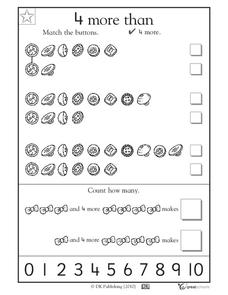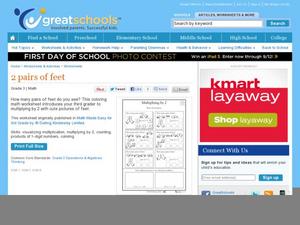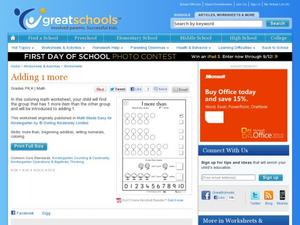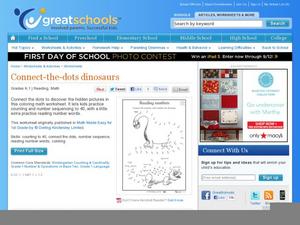DK Publishing
Adding to Sets
After adding to several sets of shapes, scholars count the number in each set and write the total in a box. There are four sets here calling for one, two, three, and four more shapes to be added to the existing figures. A final bonus...
DK Publishing
Addition, Multiplication, and Division
These equations are missing numbers, and scholars must process multiple operations to complete them. There are addition, multiplication, and division problems here, each missing an addend, divisor, or factor. After completing 24 of these...
DK Publishing
And 3 More Makes...
Addition is easier to grasp when scholars draw the addends as sets of objects. Add three more teacups to each of these four sets, calculating and recording the totals. There are four equations written out without images, each needing a...
DK Publishing
Addition Practice #2
Encourage young scholars to tap into their inner math-whiz as they add three and four-addend equations. The first 36 problems each have three addends (none over two-digit), and are written horizontally. Next, they complete eight more...
DK Publishing
5 More Than
Ready for some beachy addition practice? One of these rows of sea shells has five more than the other; learners examine sets to determine which one has five more, checking it off. Consider also asking them to write down the specific...
DK Publishing
The Same
Combine color, size, and shape recognition for youngsters using this set of shapes. They follow the directions to color big triangles red and small circles blue, then count and record the number of red triangles and blue circles....
DK Publishing
2 More Than
Which one has two more? Each row of objects has a corresponding row, and mathematicians determine which one has two more than the other, checking it off. They work with single-digit values here and should be encouraged to write the...
DK Publishing
4 More Than
Each of these sets of buttons has a corresponding set with four more. Learners examine pairs to determine which one has four more, checking it off. Consider also asking them to write down the specific number of each set to encourage...
DK Publishing
2 Pairs of Feet - Multiplying by 2
Introduce mathematicians to multiplication through counting sets of feet. Start by asking them, "How many feet are in this classroom?" See if they notice that it's easier to count pairs rather than individual feet. Scholar use the...
DK Publishing
Adding with 3-digit Numbers #2
These 25 addition problems each have two 3-digit addends, and many require regrouping. There are three examples to guide learners in all the types of problems they encounter, including the last set of five which have four-digit sums....
DK Publishing
4 Times Table
It's all about the fours as scholars practice their multiplication facts. They skip count on a number chart, shading in each multiple of four. Do they notice a pattern? Next, scholars complete five number sentenes multiplying four by...
DK Publishing
3 More Than
Which one has three more? Young mathematicians compare three sets of objects to determine which has three more, checking it off. Then, they practice beginning addition skills by examining sets of candy and adding them up for a total....
DK Publishing
3 Times Table
This 25-chart will give mathematicians a chance to detect patterns as they shade in every multiple of three by skip counting. They solve multiplication number sentences involving three and the numbers 1-5 (one is done for them.) Finally,...
DK Publishing
5 Times Table
Get scholars familiar with the fives multiplication facts using a hundreds chart and number sentences. They skip count by five on the chart, coloring in all numbers that are multiples of five. Do they see a pattern? Next, learners...
DK Publishing
Adding One More, 1 More Than
Gain familiarity with numbers 0-10 with a counting and addition worksheet for beginners. Scholars examine three pairs of circles, checking off the one representing one more than the other. Then, they read illustrated number sentences and...
DK Publishing
What's Inside?
Is it inside or outside? Learners follow directions by placing a check next to the items that are located inside. They then draw a circle inside the box. This is a great way to introduce the concepts of relative position and prepositions...
DK Publishing
Connect-the-dots Dinosaurs: Reading Numbers
Connecting dots activities can be great number sequencing practice. Here are two dinosaur dot-to-dot pictures that are intended to help learners count, sequence numbers up to 40, and recognize number words. Who doesn't love a good...
DK Publishing
Sentences #1 Worksheet
How many words are in this sentence? Emergent readers see how sentences are made up of whole words. They count the words in two simple sentences, writing the number in a box. Challenge them to read the sentence as they count, and observe...
DK Publishing
Finish the Picture
Youngsters add some shapes to this castle drawing before analyzing its geometry. They count the circles, triangles, rectangles, and squares. The objectives here include drawing, recognizing, and counting shapes as well as writing numbers...
DK Publishing
Sneaky Snakes: Counting, Part 2
Hissss! Practice counting forwards and backwards with a sly assignment. Eight snakes feature number sequences that are missing a few numbers. The beginning numbers vary, and some snakes require counting down. Learners write in the...
DK Publishing
Times Tables for Division #4
Can you practice times tables with division? Put your third graders' skills to the test with a worksheet that provides 60 division problems in the 2, 3, 4, 5, 6, and 7 times tables. Great as a timed quiz or a more formal assessment for...
DK Publishing
Stars and Planets Connect the Dots
Reach for the stars with this cute connect-the-dots activity! Kindergartners practice their counting and number sequencing by connecting the numbers 1 through 6 or 10 in four different shapes. A rocketship is completed for them as an...
DK Publishing
The Same
Which animals are the same? Youngsters draw lines connecting pictures of farm animals to their identical counterparts. They see a sheep, chick, goat, pig, and cow; the cow is done for them. Once they finish, scholars draw and color two...
DK Publishing
Learning 1 - Write the Number
Begin your study of single-digit numbers with this activity on the number one. Young counters first trace and write the digit several times. Next, they practice counting by recording how many objects are in each image (always one)....

























